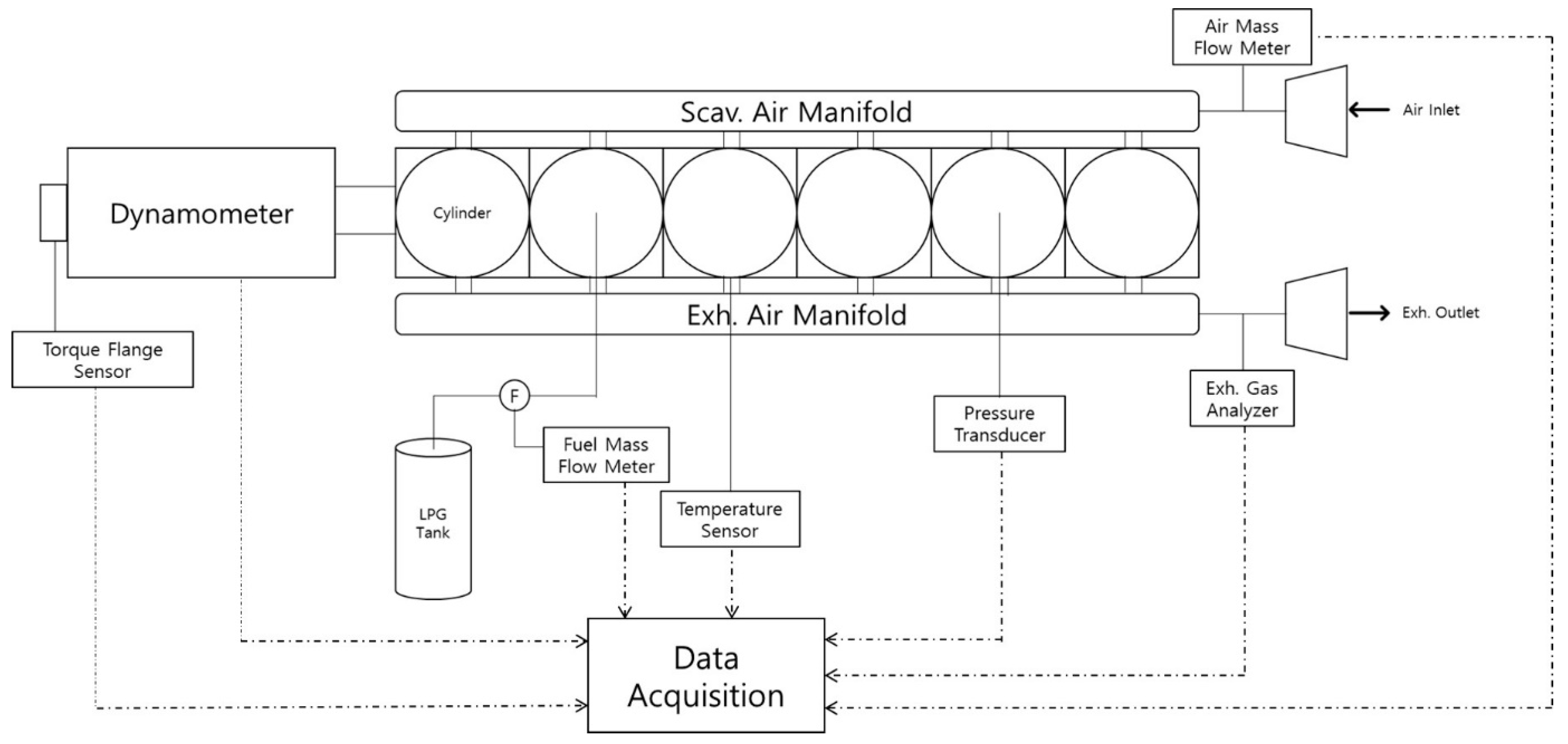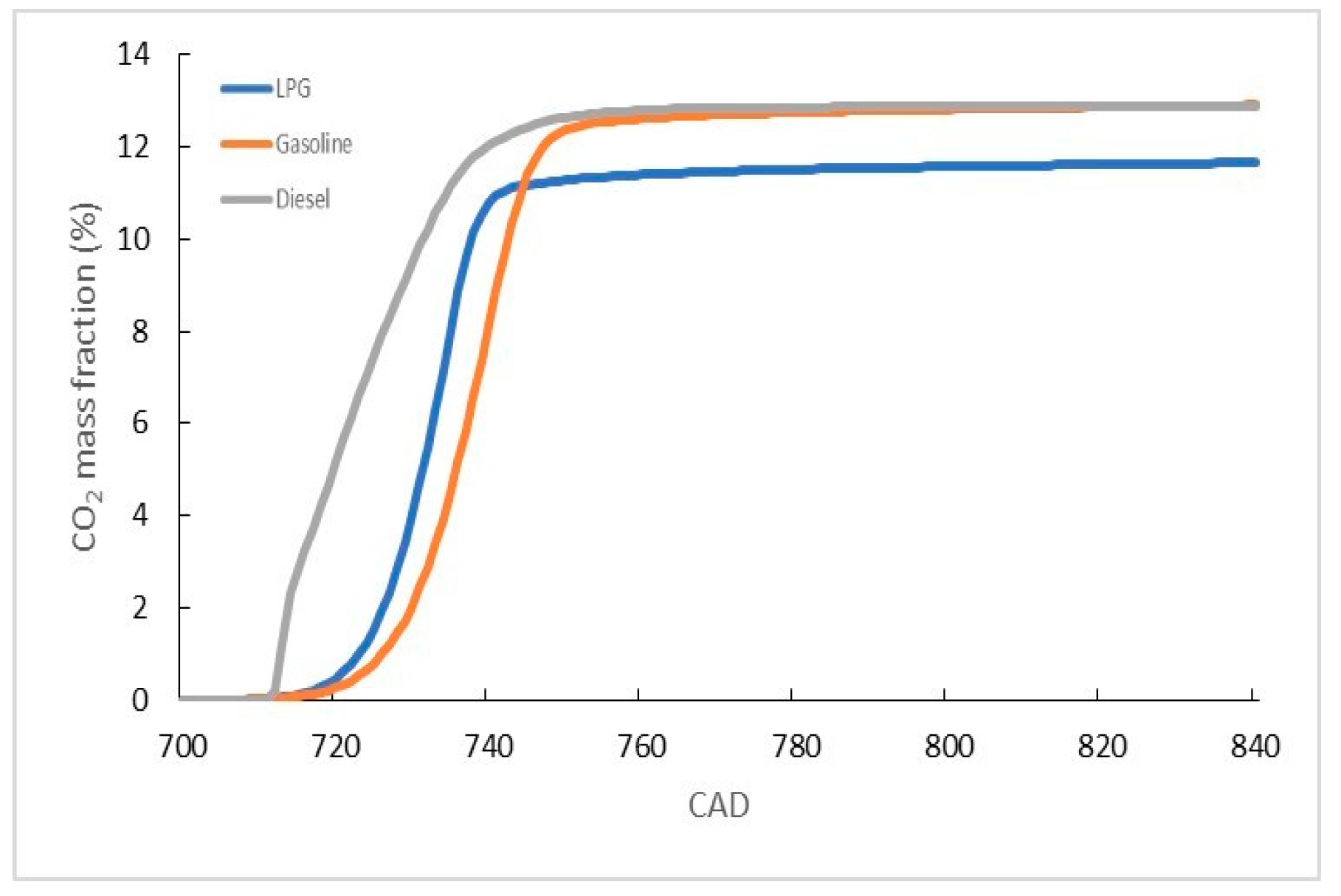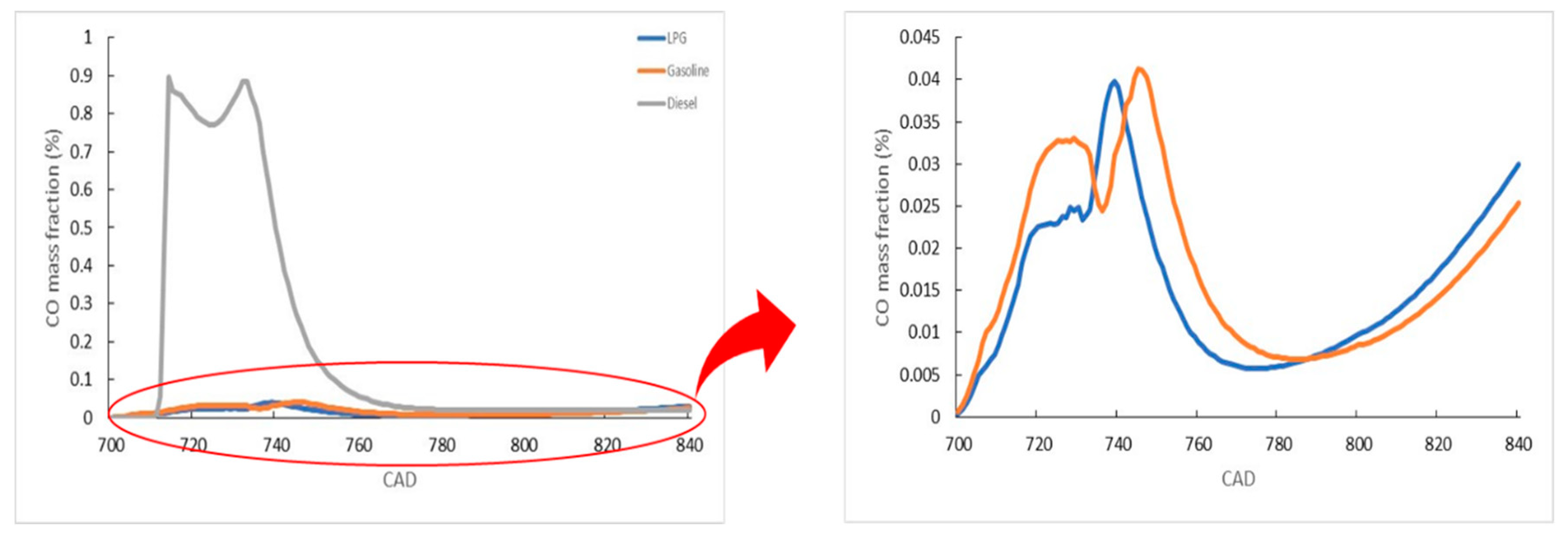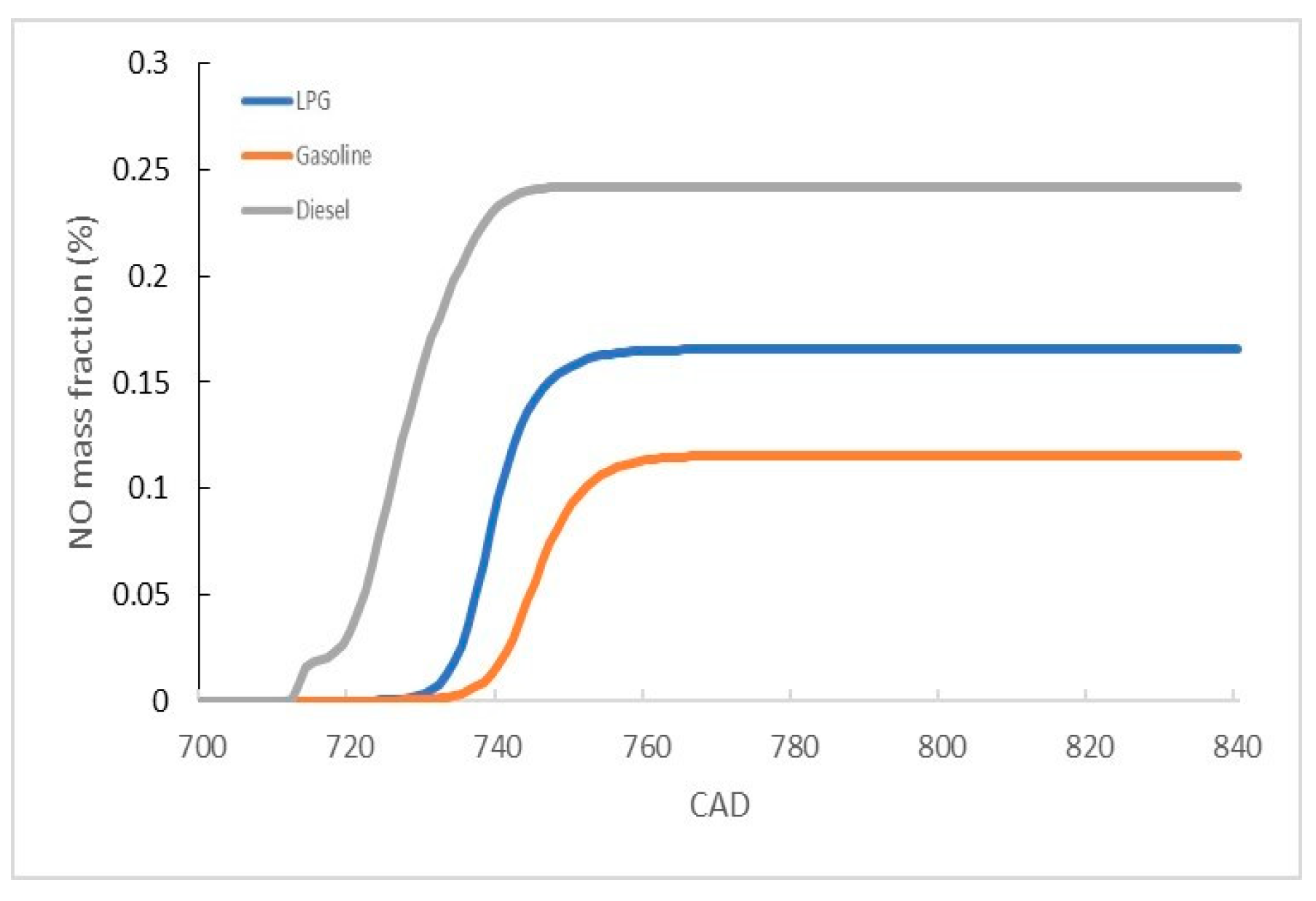LPG engines have gained recognition as environmentally friendly alternatives, showcasing reduced exhaust emissions compared to gasoline and diesel engines, and have been employed in terrestrial applications for several decades. To verify the eco-friendliness of LPG engines, this study modeled a simulated LPG engine based on a single-cylinder output under 100% load conditions of an experimental LPG engine (38.8 kW based on the indicated power). Simultaneously, models of gasoline and diesel engines with the same output were generated, and a comparative analysis of exhaust emissions was conducted through modeling.
2.2. Numerical Set-Up
In this study, the AVL FIRE ESE program was used for simulations to validate the eco-friendliness of LPG engines through a comparative analysis of exhaust emissions from gasoline and diesel engines. AVL FIRE ESE (2022 R1) is specialized software dedicated to modeling and simulating engine performance, combustion, and emission characteristics. It replicates a range of physical phenomena, including heat, flow, chemical reactions, and combustion processes, occurring within the engine, while predicting both engine performance and emission characteristics. Moreover, this program saves time and cost in the design process by predicting minute phenomena inside the engine that cannot be obtained experimentally, thereby aiding in engine optimization, performance enhancement, and compliance with emission standards. Furthermore, this software enables the prediction and analysis of engine operations using several modeling techniques employed in the simulation of various types of four-stroke engines. For an accurate prediction and analysis, establishing a simulation engine is essential to replicate the characteristics of the experimental engine.
Various information is required to configure the simulation engine, including geometric information, boundary conditions, initial conditions, and numerical models. Geometric information encompasses crucial data influencing engine operation, performance, durability, and thermal and fluid characteristics. This includes specifics, such as the shape and size of the piston and the location of the spark plug or injector. As it is desirable to use experimental information if an experimental engine is presented, the LPG simulation engine has been modeled using the geometric information of the experimental LPG engine.
Table 2 lists the geometric information used to simulate the LPG engine modeling.
The modeling of simulation engines utilizing geometric information primarily relies on three-dimensional (3D) computer-aided design (CAD) modeling of the engine and its adjacent components. This includes the size, shape, and location of the engine components. AVL FIRE ESE can directly load the shapes of the pistons and injectors in various forms, and users can model the actual engine shape accordingly by adding or modifying detailed information pertaining to the engine components within the loaded model.
Figure 2 illustrates the two-dimensional (2D) piston shape of the LPG engine modeled using AVL FIRE ESE.
Boundary conditions play an important role in controlling the behavior of the simulation model and defining the interaction between the modeling domain and the external environment. The boundary conditions required for the engine simulation are related to the main components that form the boundaries of the combustion process within the cylinder: the piston, cylinder liner, and cylinder head. These boundary conditions ensure the accuracy of the simulation and the validity of the results and are essential for modeling and predicting LPG engine operation. The boundary conditions for the simulation LPG engine modeling have been used in the experimental engine information, and
Table 3 indicates the type and input value of boundary conditions.
The initial condition is important information that defines the initial state of the simulation model and affects the accuracy of the simulation and the reliability of the results. The initial conditions for the engine simulation include variables such as cylinder supply air pressure and temperature, opening and closing timing of the intake and exhaust valves, ignition timing, and amount of fuel supplied to the cylinder. A precise setting of the initial conditions is important for ensuring the accuracy, predictability, stability, and reliability of the results and optimization of the design of the simulation model. The initial conditions for the simulation LPG engine modeling have been used in the experimental engine, and
Table 4 represents the initial conditions and their input value.
To conduct engine simulations using AVL FIRE ESE, various models must be accurately defined; these include turbulence, combustion, NOX emissions, soot, ignition, and atomization models.
The selection of a turbulence model is significant for ensuring precise outcomes because the fluid flow within an engine cylinder during simulation is inherently irregular and challenging to predict. Among the turbulence models available in AVL FIRE ESE, this study used the k-ζ-f model. This model, grounded in the Reynolds-averaged Navier (RANS) equation, is an improved model that obtains more accurate results near walls [
26]. This model demonstrates accuracy even in scenarios with high Reynolds numbers, such as fast flows, and offers the advantage of applicability even at extremely low turbulence numbers. In particular, it has the advantage of being more robust and less sensitive in calculating turbulence effects near walls with high non-uniformity. Considering these merits, it was employed to predict the turbulence, dispersion, turbulence energy loss, and turbulence resistance generated at the wall.
Given that the combustion model can forecast post-combustion attributes, including the type and concentration of chemicals produced throughout the combustion process as well as factors such as heat, pressure, and noise, the program seeks to simulate the combustion process occurring within the engine by incorporating diverse chemical reaction equations and combustion mechanisms. This study employed the Extended Coherent Flame Model-3 Zones (ECFM-3Z) among the five Coherent Flame Model (CFM) from the combustion models available in the AVL FIRE ESE [
27]. This model distinguishes itself by partitioning the combustion zone into pre-flame, flame, and post-flame zones and applying distinct combustion reaction rates to each zone. Owing to the different reaction rates in each zone, the speed and nature of the combustion are more realistic and enhance the overall precision of the simulation results.
The NO
X emission model in the simulation program is a crucial element in the combustion process since NO
X is generated through the reaction of atmospheric nitrogen and oxygen during high-temperature combustion. Its production is contingent upon combustion environmental conditions, such as fuel type, fuel injection timing, chemical reactions, and airflow, and these conditions are subject to change. In this study, the Extended Zeldovich model was employed as the NO
X emission model [
28,
29,
30]. This model overcomes the disadvantage of being unable to accurately calculate NO
X production because of the lack of oxygen in a rich combustion environment. Furthermore, the model incorporates advanced functionalities, including the generation and depletion of NO
X, the reaction of NO
X with oxygen, and chemical decomposition.
Soot is a byproduct of combustion and is generated as a result of incomplete combustion in engines. It is classified as an air pollutant and is recognized as an important factor in modeling simulation engines in that it affects engine performance and durability. Although various soot models exist for predicting the total mass, size distribution, and composition generated during the fuel injection and combustion processes, this study employed the kinetic model [
28,
29]. The kinetic model involves four steps, involving the calculation of the reaction thermodynamics and particle motion to estimate the size distribution and transport speed of the generated soot particles. This model considers various chemical reactions depending on the engine operating conditions and can accurately model the amount and characteristics of emissions by efficiently calculating and estimating all the chemical reactions, particle growth, and particle combustion processes.
The ignition model, which is crucially dependent on fuel characteristics, plays a significant role in modeling the simulations. In this study, a spark-ignition model was used to simulate an LPG engine. This model replicates the process through which a spark plug initiates a flame within a compressed cylinder containing a fuel–air mixture. Moreover, by considering various parameters, the shape, density, and temperature of the flame are predicted, and the combustion characteristics and performance of the fuel are analyzed.
The atomization model of AVL FIRE ESE includes breakup, evaporation, and droplet–wall interaction models. In this study, the wave, Dukowicz, and Walljet1 models were used for breakup, evaporation, and droplet–wall interactions, respectively [
28,
31]. The breakup is a model that explains the process of dispersing fuel particles into smaller fragments. The wave model, which is one of the breakup models, calculates and predicts the size, speed, and density of particles during the fuel injection process through detailed fuel particle modeling at the molecular level. The evaporation model predicts and explains how the atomized fuel particles are evaporated in fuel and air environments after injection. The Dukowicz model considers the heat and mass characteristics of the particles and predicts changes in the particle size, speed, and density, thereby enabling accurate modeling and prediction of the evaporation rate and particulate behavior. The Walljet1 model, one of the droplet–wall interaction models, forecasts particulate interactions with the engine wall. This model tracks and predicts particulate movement and distribution based on wall characteristics, thereby enabling collisions with or movement along the wall to be accurately modeled and predicted.
Table 5 details the simulation models applied in this study.
To compare the exhaust emissions of LPG engines with gasoline and diesel engines using simulation, additional modeling for gasoline and diesel engines is required. In this study, LPG engine modeling parameters were used, except for the parameters that needed to be changed to suit the characteristics of gasoline and diesel engines. Since the gasoline engine is the same spark-ignition engine as the LPG engine, the LPG engine simulation modeling parameters were used, and only the equivalent ratio was changed for comparison under the same power conditions. For the diesel engine, the compression ratio, injection nozzle, ignition model, and fuel injection parameters were changed. The compression ratio was increased from 9.5:1, the LPG engine compression ratio, to 18.0:1. For the injector, the angle of the nozzle was set to 155°, and the number of nozzle holes was set to five [
32,
33,
34]. The charging air pressure of a diesel engine can affect emission at the same power and is determined during the engine optimization process. Since the air intake pressure of the experimental LPG engine was 135 kPa, which is within the inlet manifold pressure range of 100 to 250 kPa for a typical turbocharged diesel engine, it was not considered a modified parameter. Additionally, the ignition model was changed from spark ignition to auto-ignition, and the fuel injection amount was adjusted for comparison under the same power conditions.
Table 6 lists the modified parameters for gasoline and diesel engine modeling.
Additionally, revealing the properties of each fuel is essential for comparing the exhaust emissions of the fuels used in LPG, gasoline, and diesel engines.
Table 7 presents the properties of the fuels used in this study.
2.3. Validation of Simulation Model and Mesh Independence Analysis
In this study, three parameters—maximum pressure, indicated mean effective pressure (IMEP), and CO
2—were compared between the experimental and simulation results to verify the accuracy and reliability of the simulation LPG model. This aimed to use the validated simulation LPG engine to assess the exhaust emissions comparison with gasoline and diesel engines. NO emissions were excluded from the parameters because of the three-way catalyst device installed at the rear of the experimental engine exhaust. The results of the validation are shown in
Figure 3 by comparing the experimental and simulation outcomes.
The comparison results show deviations of 3.6%, 0.7%, and 4.3% in the maximum pressure, IMEP, and CO
2 emissions, respectively. In addition, the overall operating state of the simulated LPG engine was verified using the P–θ and P–V diagrams.
Figure 4 compares the P–θ and P–V diagrams of simulation and experiment.
To implement the combustion chamber shape of the simulation engine as a 3D shape, a computational mesh must be created. When using a high-resolution mesh, the accuracy of the simulation results is high, but the calculation time increases, and vice versa. Therefore, a mesh independence analysis must be performed to ensure the accuracy of the simulation results and a reasonable calculation time. This strategy allows the selection of an appropriate mesh resolution that can calculate accurate simulation results in a short period. In this study, a mesh independence analysis was conducted considering three cases, wherein the cell size was altered by ±10%, with the intermediate mesh serving as a reference.
Table 8 lists the mesh properties and calculation times for each mesh resolution and
Figure 5 shows the mesh independence analysis results.
The mesh independence analysis of the simulation LPG engine using three mesh resolutions revealed that it does not depend on the mesh resolution. In this study, the intermediate mesh was selected for the simulation in that it provides independent calculation results using the mesh and has an appropriate density for good contour analysis in the next step, along with a reasonable time for the calculation process.
2.4. Results on Eco-Friendliness
Since an engine’s emission is affected by cylinder pressure and temperature, comparing the cylinder pressure and temperature of each engine can be important prior to comparing the emission results.
Figure 6 presents the comparison of cylinder pressure and temperature of LPG, gasoline, and diesel engines at the same output.
To assess the eco-friendliness of LPG engines, the CO
2, CO, NO, and soot emissions of the simulation LPG, gasoline, and diesel engines were compared under the same output conditions.
Table 9 presents the output (100% load), fuel consumption, mean mass per cycle of each engine, emission mass fraction of each engine, and the amount of emission in g/kWh of each engine.
Figure 7 presents the comparison results of CO
2 emissions at the same output.
CO2 emissions were similar for the gasoline and diesel engines, and the LPG engine showed 11.35% and 4.59% lower CO2 emissions compared to gasoline and diesel engines, respectively. CO2 is an air pollutant that causes GHG emissions, and massive efforts are underway to reduce emissions. Based on the CO2 emissions comparison results, the conversion of gasoline and diesel engines into LPG engines in small fishing boats can be considered an alternative for reducing GHG emissions.
Figure 8 compares CO emissions at the same output of the LPG, gasoline, and diesel engines.
The comparison reveals that CO emissions from diesel engines surpass those from LPG and gasoline engines. This arises from differences in combustion processes, fuel injection and mixing methods, and fuel characteristics. Unlike LPG and gasoline engines that employ spark ignition, diesel engines employ compression ignition. This relies on the spontaneous ignition of fuel due to the heat generated by compressed air, which increases CO generation if the air temperature is insufficient during compression. In addition, unlike LPG and gasoline engines, which premix air and fuel before supplying the mixture to the cylinder, diesel engines directly inject fuel into the cylinder. This may lead to insufficient or irregular mixing of air and fuel, which is attributed to the inherent fuel injection and mixing characteristics of diesel engines. Furthermore, the higher carbon content of diesel fuel, in comparison to LPG and gasoline, heightens CO generation owing to incomplete combustion. The LPG engine exhibited 5.17% and 95.31% lower CO emissions than the gasoline and diesel engines, respectively.
Figure 9 presents a comparison of NO emissions at the same output for the LPG, gasoline, and diesel engines.
The comparison of NO emissions reveals the order of diesel > LPG > gasoline, with the LPG engine exhibiting 39.63% higher emissions than the gasoline engine and 28.19% lower emissions than the diesel engine. Generally, NO emissions arise from atmospheric nitrogen and oxygen supplied to the engine, which undergoes a chemical reaction and produces NO during the combustion process. For diesel engines, higher NO emissions are attributed to the characteristics of the surcharging air. For LPG and gasoline engines, the higher NO emissions from LPG can be attributed to the air–fuel mixing ratio. The equivalence ratios for LPG and gasoline at the same output are 0.652 and 0.669, respectively. This implies that the LPG engine has a higher air ratio in the air–fuel mixture compared to the gasoline engine, leading to higher NO generation in the LPG engine.
Figure 10 compares soot emissions at the same output from the LPG, gasoline, and diesel engines.
The higher production of soot in diesel engines compared to LPG and gasoline engines can be attributed to the characteristics of the fuel and combustion processes. The high carbon content of diesel fuel, coupled with partial combustion and chemical reactions occurring in the flame owing to compression ignition and direct fuel injection combustion processes, facilitates soot formation. The LPG engine exhibited 92.55% and 98.58% lower soot emissions than the gasoline and diesel engines, respectively.
The aforementioned results clearly demonstrate that LPG engines exhibit greater eco-friendliness than gasoline and diesel engines for all exhaust emissions, except for NO emissions, for which they surpass gasoline. Thus, the eco-friendly attributes of LPG engines play a pivotal role in enhancing air quality, mitigating environmental pollution, and curbing GHG emissions. Consequently, installing LPG engines in small ships offers environmental protection and provides a sustainable mode of transportation.
However, the gasoline and diesel engines implemented using simulation in this study have not been verified with those engines used in actual small fishing boats, so there is a disadvantage in that it is difficult to 100% trust the exhaust emission results of the simulated engines. Despite the shortcomings, the exhaust emission results of this study are consistent with previous studies [
9,
18,
19,
35,
36,
37]. It is expected that more accurate results will be derived in the future through simulation modeling using gasoline and diesel engine information from real ships.















